Orange Order in the great white north : Canada’s storm troopers of the Tories revisited
Nov 14th, 2005 | By Randall White | Category: Heritage Now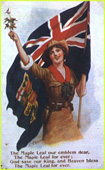 With all the current talk about old and new Canadas, it was intriguing to spend a grey November Saturday at an almost colourful history conference in the University of Toronto’s traditionally Catholic St. Michael’s College. The unlikely subject was “The Orange Order in Canada.” The Orange Order, in the apt formula of Donald MacRaild from Victoria University in New Zealand, was both a legendary “anti-Catholic club,” and a more admirable “socio-economic network,” in the now vanished old British North America and similar places elsewhere.
With all the current talk about old and new Canadas, it was intriguing to spend a grey November Saturday at an almost colourful history conference in the University of Toronto’s traditionally Catholic St. Michael’s College. The unlikely subject was “The Orange Order in Canada.” The Orange Order, in the apt formula of Donald MacRaild from Victoria University in New Zealand, was both a legendary “anti-Catholic club,” and a more admirable “socio-economic network,” in the now vanished old British North America and similar places elsewhere.
For added amusement, the November 2005 conference in Toronto was held on the 400th anniversary of Guy Fawkes’s foiled Gunpowder Plot in the United Kingdom – when at least some Catholics tried to blow up the Protestant English Parliament. As several speakers alluded to, despite its widely acknowledged historical importance the Canadian Orange Order has not as yet been studied much by the historical profession. But this is starting to change. And that is no doubt a good thing, from various points of view.
The secret history of Orange Canada …
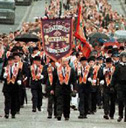 The political historian P.B. Waite (among others) made clear some time ago that, in the 19th and earlier 20th centuries, “the Orangemen” were “the storm troopers of the Tories” in Canadian politics. But like other practitioners of his craft, he was perhaps still a little too ashamed of the Orange Order in Canada to go into all this in much further detail.
The political historian P.B. Waite (among others) made clear some time ago that, in the 19th and earlier 20th centuries, “the Orangemen” were “the storm troopers of the Tories” in Canadian politics. But like other practitioners of his craft, he was perhaps still a little too ashamed of the Orange Order in Canada to go into all this in much further detail.
Part of the difficulty was that until recently the original Orange Order across the sea was still adding fuel to the flames of the tribal troubles in Northern Ireland. The embers of these fires still sometimes seem more alive than they ought to be. But the flames themselves have lately subsided. And that is probably part of the new context that made it possible for St. Michael’s College to host a conference about the old Canadian Orangeism, on November 5, 2005.
The official arrival of the new multicultural Canada, in the early 21st century age of Adrienne Clarkson and then Michaelle Jean, at Rideau Hall in Ottawa, probably helped make the conference possible too. (Along, it would seem, with some fresh transatlantic funding interest, opened up by such present-day British historians as Linda Colley?) In Canada there no longer appears to be any real danger that just talking about the old Orange Order will somehow bring its worst bad habits back to life.
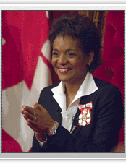 It is true that a Toronto Globe and Mail online poll for Sunday, November 6, 2005 showed 72% of more than 28,000 respondents answering Yes to the question: “Are riots like the ones seen in Paris this week likely ever to occur in Canada?” Newer versions of many of the forms of human conflict which the Orange Order once worked so hard to enflame are still alive and well enough even in the new multicultural Canada – as in other parts of the global village today.
It is true that a Toronto Globe and Mail online poll for Sunday, November 6, 2005 showed 72% of more than 28,000 respondents answering Yes to the question: “Are riots like the ones seen in Paris this week likely ever to occur in Canada?” Newer versions of many of the forms of human conflict which the Orange Order once worked so hard to enflame are still alive and well enough even in the new multicultural Canada – as in other parts of the global village today.
Who knows exactly where the challenges of coping with these new versions of old cultural, social, and theological antagonisms will eventually lead Canada (and the neighbouring giant in the United States, or Australia, New Zealand, Canada’s first European mother country of France, and so forth)? Yet no at all politically serious voices nowadays are urging that the kinds of remedies once proposed by the Orange Order in Canada any longer make sense for anyone.
One proof for all this was the 2005 Guy Fawkes Day conference at St. Michael’s College itself. It was agreeably ironic that Toronto’s most eminent Catholic educational institution hosted such a fundamentally charitable autopsy of a sinister anti-Catholic scourge from days gone by. And there was good humour on all sides. Laughing at the past can no doubt be a healthy activity in its own right. And there is nowadays much to laugh about, respectfully enough, in the past of the Orange Order in Canada (even if some of it does involve the old African American tradition of “laughing to keep from crying”).
“The International Context of Canadian Orangeism”
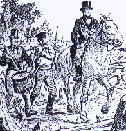 The best way to convey the main thrusts of the conference is to quickly sketch the presentations made by its nine (or 10 or even 11) different speakers. Social historian Donald MacRaild from New Zealand was first up, with a report on “The Associationalism of the Orange Diaspora.”
The best way to convey the main thrusts of the conference is to quickly sketch the presentations made by its nine (or 10 or even 11) different speakers. Social historian Donald MacRaild from New Zealand was first up, with a report on “The Associationalism of the Orange Diaspora.”
The Orange Order began in Northern Ireland in 1795. In the 19th century it spread to assorted British possessions overseas, along with the (Scots-) Irish Protestant migrants whose narrow ideals for a growing English-speaking world it embodied. MacRaild also stressed that the Orange Order was an essentially working-class movement, as well as a kind of secret society.
Strangely enough, on some views, it was a largely right-wing working-class movement, fiercely anti-Catholic and loyal to the Protestant British Crown. It supplied storm troopers for the conservative Tory party politically. But it was equally a socio-economic support network for working people, at a time when governments, trade unions, and the private insurance industry provided even less mass economic security than they do now.
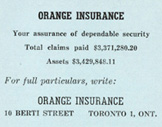 (There are as yet still vague pieces of evidence about how, in 20th century Canada, a few more politically radical Orangemen would finally go on to help form the left-wing Co-operative Commonwealth Federation, and its New Democratic Party successor. And the history of the old Orange Order might even have some slight wider North American interest today, when some sort of new right-wing working-class movement, with strong religious overtones, is apparently doing a lot to prop up the Republican Party of George W. Bush in the USA.)
(There are as yet still vague pieces of evidence about how, in 20th century Canada, a few more politically radical Orangemen would finally go on to help form the left-wing Co-operative Commonwealth Federation, and its New Democratic Party successor. And the history of the old Orange Order might even have some slight wider North American interest today, when some sort of new right-wing working-class movement, with strong religious overtones, is apparently doing a lot to prop up the Republican Party of George W. Bush in the USA.)
Eric Kaufmann, who followed Donald MacRaild, teaches in Birbeck College at the University of London. But his voice soon betrayed his North American origins. A self-confessed social scientist, he presented an assortment of intriguing statistical evidence on “The Orange Order in Ontario, Newfoundland, Scotland, and Northern Ireland.” One of his charts dramatically showed how Canadian Orangeism peaked after the First World War, in the early 1920s. (At this point there were more than twice as many Orangemen in Canada as in the United Kingdom.)
James McConnel from the University of Ulster rounded out the first part of the presentations with a paper called “Remembering the 5th: Nineteenth-Century Commemorations of the Gunpowder Plot in Canada, Ireland and the Dominions.” Official commemorations by law of the foiled terrorist act of 1605 against the Protestant English Parliament had ended in 1859 in the United Kingdom. But the loyal Orangemen overseas were still vigorously celebrating Guy Fawkes Day during modern Canada’s confederation era of the 1860s.
“Toronto: The Belfast of Canada”
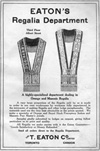 The theory and practice of Orangeism eventually made inroads in almost all parts of what is now Canada, but it was more important in some parts than others. Most urbane Torontonians today do not warm to the thought that the Orange Order in Canada was arguably most important in earlier incarnations of their city (including the one of which a visiting Charles Dickens once said: “the rabid Toryism of Toronto is, I speak seriously, appalling”). But this is nonetheless true.
The theory and practice of Orangeism eventually made inroads in almost all parts of what is now Canada, but it was more important in some parts than others. Most urbane Torontonians today do not warm to the thought that the Orange Order in Canada was arguably most important in earlier incarnations of their city (including the one of which a visiting Charles Dickens once said: “the rabid Toryism of Toronto is, I speak seriously, appalling”). But this is nonetheless true.
During the first half of the 19th century both Green working-class Irish Catholics and Orange working-class Irish Protestants settled in the rising city on the northwestern shore of Lake Ontario, at the foot of an ancient aboriginal canoe portage to the wide open spaces of the Canadian Northwest. And they brought their traditions of conflict in the old world to the vast and rugged northern North American wilderness.
So, after the lunch break at the November 2005 St. Michael’s College conference, urban historian Brian Clarke from the University of Toronto re-started the proceedings with a talk on “Religious Riot as Pastime: Orangemen, Parades, and Public Life in Victorian Toronto.” He described how during the first generation of the modern Canadian confederation rival local groups of Green and Orange young men, literally numbering in the thousands, recurrently rioted and fought each other on at least a select few city streets – as a form of manly public recreation.
 The height of this activity, Clarke reported, was in the 1870s, when by his count 14 such recreational riots took place. By the late 1890s public pressure, aided and abetted by a growing local police force, had largely put an end to the pastime.
The height of this activity, Clarke reported, was in the 1870s, when by his count 14 such recreational riots took place. By the late 1890s public pressure, aided and abetted by a growing local police force, had largely put an end to the pastime.
The adult Orange Order, which also had a strong temperance streak, did not approve of the drinking habits of many Orange youths involved. And the local Irish Catholic minority, whose presence so incensed all Orangemen, was taking up an increasingly smaller proportion of the growing city’s population. Brian Clarke does not feel that the epithet “Belfast of Canada,” with which some once tried to summarize late 19th century Toronto, makes all that much sense.
The next speaker was William Jenkins, an urban geographer from York University in Toronto. His talk was called “Mapping local and transnational dimensions of Orangeism in early twentieth-century Toronto.” He pointed to various geographic clusters of the city’s old Orange culture, such as the east-end neighbourhood along Gerrard Street west of Coxwell Avenue, now home to a “Little India” commercial strip, as well as the remnants of an old Orange lodge.
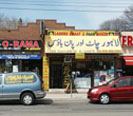 Jenkins also suggested that at least some sides of Brian Clarke’s earlier Orange youth culture were still around after the First World War. And culturally aggressive Toronto Orange parades on the 12th of July remained big things in the 1920s. (They were not exactly riotous, but their essential harsh message was that this city, and this country, belonged to White Anglo-Saxon Protestants. And you better believe it, whoever you were.)
Jenkins also suggested that at least some sides of Brian Clarke’s earlier Orange youth culture were still around after the First World War. And culturally aggressive Toronto Orange parades on the 12th of July remained big things in the 1920s. (They were not exactly riotous, but their essential harsh message was that this city, and this country, belonged to White Anglo-Saxon Protestants. And you better believe it, whoever you were.)
In theory, the parades on the 12th of July commemorated an ancient Protestant victory in Ireland, at the Battle of the Boyne in 1690. In the early 20th century, William Jenkins also reported, many Toronto Orangemen were still staunchly opposed to home rule for the Irish Catholic majority in the homeland across the sea. (It finally arrived anyway in 1922. But there is still much interest in newer transnational political conflicts in Toronto today. Note, e.g., the early 21st century Chinese Torontonians who support Falun Gong, and are staunchly opposed to the current repressive policy against this movement in the People’s Republic of China, across another sea.)
“Orangeism and Confederation”
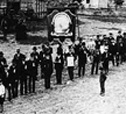 As noted, if Toronto was the place where Orange Canada reached the height of its historical influence, it was far from the only part of the country where the Order carried public weight and heft. Orangeism was also prominent in many parts of Southern Ontario, in Newfoundland and the Maritime Provinces, in the new Western Canada, and even, in certain ways at least, in Quebec.
As noted, if Toronto was the place where Orange Canada reached the height of its historical influence, it was far from the only part of the country where the Order carried public weight and heft. Orangeism was also prominent in many parts of Southern Ontario, in Newfoundland and the Maritime Provinces, in the new Western Canada, and even, in certain ways at least, in Quebec.
At the St. Michael’s College conference David A. Wilson from the University of Toronto took up this last theme, in a talk called “Orange Influences of the Right Kind’: D’Arcy McGee, Orangeism and the Confederation of Canada 1867.” This focused on the story of Thomas D’Arcy McGee, who after assorted adventures elsewhere wound up as an unusual Irish Catholic conservative politician in Montreal. Here he ardently embraced John A. Macdonald’s and Georges Etienne Cartier’s campaign for a new monarchical confederation of the British North American provinces, in the 1860s era of the American Civil War.
There are various strange byways in the career of Darcy McGee, up to and including his assassination in 1868 by an Irish Catholic revolutionary in Ottawa. According to David Wilson’s wife, the greatest mystery about McGee is why someone hadn’t assassinated him much earlier. But what Wilson himself stressed in his talk on November 5, 2005 was how the Irish Catholic McGee’s Canadian experience, in the middle of the 19th century, ultimately gave him a certain respect for what he called “Orange influences of the right kind.”
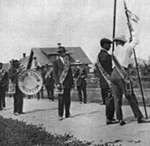 The already diverse Macdonald-Cartier “Liberal Conservative” party, that did so much to establish the new Canadian confederation of 1867, drew on an exotic mixture of popular support. It included both Macdonald’s Orange Protestant storm troopers of the Tories in the rest of Canada, and Cartier’s French Catholic Bleus in Quebec. In the midst of this challenging political alliance at least some parts of the Orange Order moderated their anti-Catholicism, in the larger interest of a new Canada that had some kind of room for both English and French. (As well as the larger conservative interest of what Cartier called “the monarchical principle,” and Macdonald and his Orange supporters saw as the United Empire and the British Crown).
The already diverse Macdonald-Cartier “Liberal Conservative” party, that did so much to establish the new Canadian confederation of 1867, drew on an exotic mixture of popular support. It included both Macdonald’s Orange Protestant storm troopers of the Tories in the rest of Canada, and Cartier’s French Catholic Bleus in Quebec. In the midst of this challenging political alliance at least some parts of the Orange Order moderated their anti-Catholicism, in the larger interest of a new Canada that had some kind of room for both English and French. (As well as the larger conservative interest of what Cartier called “the monarchical principle,” and Macdonald and his Orange supporters saw as the United Empire and the British Crown).
In this sense it could be said that Canadian Orangeism played an important role in establishing the Canadian confederation of 1867. And, strangely enough again, the role would be revived, in a somewhat different form, when Newfoundland finally completed the modern Canadian political project by joining the confederation at last, more than 80 years later.
At the St. Michael’s College conference the last point here was taken up by John Fitzgerald, from Memorial University in St. John’s, Newfoundland, in a talk called “The Orange Order and the Confederation of Newfoundland and Canada, 1949.” As Fitzgerald urged, the story of how Newfoundland finally joined Canada in the middle of the 20th century is still not well known in Canada at large, or anywhere else outside Newfoundland.
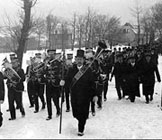 Historically as well, if there was one part of Canada today where Orangeism was once almost as influential as it was in earlier incarnations of Toronto, it was probably Newfoundland. This was partly because The Rock was also home to a very large Catholic minority (more than 40% of the population at the end of the Second World War). And perhaps because the Newfoundland Catholic hierarchy still saw English Canada as a place that would only boost the weight of the local Orangemen, it spoke out against joining the original British dominion in the late 1940s.
Historically as well, if there was one part of Canada today where Orangeism was once almost as influential as it was in earlier incarnations of Toronto, it was probably Newfoundland. This was partly because The Rock was also home to a very large Catholic minority (more than 40% of the population at the end of the Second World War). And perhaps because the Newfoundland Catholic hierarchy still saw English Canada as a place that would only boost the weight of the local Orangemen, it spoke out against joining the original British dominion in the late 1940s.
In any case, it took two referendums in 1948 to bring Newfoundland into the confederation at last, and the result of the second vote was close. Sensing this beforehand, the confederate supporters finally pulled out all the stops and “played the Orange card,” which proved pleased to be played. In the end, John Fitzgerald suggested, there are still those who urge that “every right-thinking Protestant went out and voted against the Catholics.” The result was that the Canadian confederate cause won by a whisker – in “one of the last flourishes of traditional Orange political power” in the old British North America.
“Monarchism and Modernism”
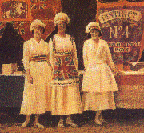 By this point in the afternoon recurrent ironic laughter from the lively 21st century audience had been punctuating the St. Michael’s College conference for some time. And the next speaker, Ian Radforth from the University of Toronto, who spoke on “Orangeism and Monarchy in Canada,” heightened the trend.
By this point in the afternoon recurrent ironic laughter from the lively 21st century audience had been punctuating the St. Michael’s College conference for some time. And the next speaker, Ian Radforth from the University of Toronto, who spoke on “Orangeism and Monarchy in Canada,” heightened the trend.
Radforth’s main story was that the Orange Order in Canada believed fervently in a united British empire, that was staunchly loyal to what is still legally the Protestant British monarchy today. But the British Crown and its evolving official establishment in northern North America never altogether welcomed the support that the storm troopers of the Tories were so eager to provide. As a case in point, Radforth explored the great torments that the Orange Order in what is now Ontario induced in the young Prince of Wales’s royal visit to British North America in 1860.
The Orangemen in what was then officially known as Canada West were very eager to show their loyalty to the British monarchy, by parading in their full regalia and erecting triumphal Orange arches in the rising cities, towns, and villages north of the Great Lakes, under which the young prince might pass in splendor. But the high-minded officials of the Colonial Office across the sea, who were escorting His Royal Highness, were all too aware that northern North America was already a quite diverse country, with sharp ethnic and religious tensions (starting but not ending with the French Catholics in Canada East). And they were determined not to officially associate the royal family from far-away Buckingham Palace with the local Orange Order.
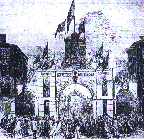 The result was recurrent incidents in which the visiting royal party approached particular pioneer settlements, only to notice gathering hordes of welcoming Orangemen in the distance. At this point the royal party would turn away from its destination – at least until the public spaces had been cleared of friendly Orange demonstrators. The Orangemen themselves were of course not pleased. And the whole process quickly became too much for John A. Macdonald, who had begun as the popular local political representative on the royal tour. Early on Macdonald sought refuge at a friendly tavern in his home town of Kingston, CW, where he is said to have remained for the rest of the young prince’s official visit.
The result was recurrent incidents in which the visiting royal party approached particular pioneer settlements, only to notice gathering hordes of welcoming Orangemen in the distance. At this point the royal party would turn away from its destination – at least until the public spaces had been cleared of friendly Orange demonstrators. The Orangemen themselves were of course not pleased. And the whole process quickly became too much for John A. Macdonald, who had begun as the popular local political representative on the royal tour. Early on Macdonald sought refuge at a friendly tavern in his home town of Kingston, CW, where he is said to have remained for the rest of the young prince’s official visit.
(It is even today not too much of a secret of Canadian history that Macdonald, who would go on to become the modern 1867 confederation’s founding first prime minister, was a confirmed alcoholic. But his bad habits become more understandable as you learn about the vast human difficulties involved in keeping together his and George Etienne Cartier’s exotic political alliance, which finally made the new confederation possible. After Macdonald passed from the scene in the 1890s, his Conservatives could find no equally alcoholic English Canadian successor. And the Liberals under Wilfrid Laurier from Quebec took over the historic mantle of Canada’s natural governing party. As just one sign of how the human difficulties persisted even under the Liberals, when Pierre Trudeau became prime minister of Canada in 1968, he pointedly moved into Cartier’s and not Macdonald’s old office, on Parliament Hill in Ottawa.)
 With Ian Radforth’s talk having brought the audience to the very edge of its 21st century sense of humour, the formal presentations at the St. Michael’s College conference ended with two linked talks by Cecil Houston of the University of Windsor in Ontario, and W.J. Smyth from the National University of Ireland at Maynooth. Houston and Smyth are the authors of a much admired book of 1980 called The Sash Canada Wore – which did a great deal to establish present-day scholarly interest in the history of the Orange Order in the old British North America.
With Ian Radforth’s talk having brought the audience to the very edge of its 21st century sense of humour, the formal presentations at the St. Michael’s College conference ended with two linked talks by Cecil Houston of the University of Windsor in Ontario, and W.J. Smyth from the National University of Ireland at Maynooth. Houston and Smyth are the authors of a much admired book of 1980 called The Sash Canada Wore – which did a great deal to establish present-day scholarly interest in the history of the Orange Order in the old British North America.
The collective final assignment of Houston and Smyth at the conference was to speak on “The Faded Sash: Orangeism in Canada, 19202005.” Houston began with some remarks acknowledging that the traditional political power of the Orange Order in the old British North America peaked around 1920. He then quickly went on to note that the Order nonetheless remains extant even today, in much more modest and rather different forms. And his own genial personality spoke eloquently for its kinder and gentler side.
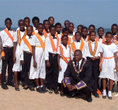 (There was an Italian “Garibaldi Lodge” of the Orange Order in Toronto as early as the 1930s. According to one source on the Internet, there are still more than a dozen Orange lodges in Ontario among the modern Six Nations Iroquois – who were officially declared “British subjects” as long ago as the 1713 Treaty of Utrecht, among the European powers of the day. Internationally, according to another Internet source: “There are currently about 20 Orange lodges in west Africa and membership at a number of youth lodges in Ghana is increasing, which seems to augur well for the future of the Order in that area. The revival in Orangeism has coincided with the return of democracy to Ghana.” A late 19th century Ontario Orangeman would no doubt find all this astounding, and probably somewhat befuddling as well.)
(There was an Italian “Garibaldi Lodge” of the Orange Order in Toronto as early as the 1930s. According to one source on the Internet, there are still more than a dozen Orange lodges in Ontario among the modern Six Nations Iroquois – who were officially declared “British subjects” as long ago as the 1713 Treaty of Utrecht, among the European powers of the day. Internationally, according to another Internet source: “There are currently about 20 Orange lodges in west Africa and membership at a number of youth lodges in Ghana is increasing, which seems to augur well for the future of the Order in that area. The revival in Orangeism has coincided with the return of democracy to Ghana.” A late 19th century Ontario Orangeman would no doubt find all this astounding, and probably somewhat befuddling as well.)
W.J. Smyth carried on the collective concluding remarks with some further evidence about Orangeism in Canada today. There are, e.g., only four Orange lodges within the boundaries of the old 1920s city of Toronto in 2005. Saskatchewan, which once ranked second to Ontario in provincial distributions of lodge numbers, now has none.
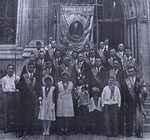 At the same time, W.J. Smyth is a former president of the National University of Ireland at Maynooth (“situated approximately 15 miles from Dublin in the heart of the Kildare countryside”). But in his youthful academic travels he taught for a time at the University of Toronto, in the 1970s. And he genially took some polite exception to Brian Clarke’s earlier view that “the Belfast of Canada” was not in the end a very apt characterization of the city of Toronto in some of its earlier incarnations.
At the same time, W.J. Smyth is a former president of the National University of Ireland at Maynooth (“situated approximately 15 miles from Dublin in the heart of the Kildare countryside”). But in his youthful academic travels he taught for a time at the University of Toronto, in the 1970s. And he genially took some polite exception to Brian Clarke’s earlier view that “the Belfast of Canada” was not in the end a very apt characterization of the city of Toronto in some of its earlier incarnations.
Even after it reached the height of its influence around 1920, Smyth quite accurately stressed, the Orange Order played a dominant role in Toronto municipal politics down to the late 1950s. In the first half of the 20th century there was what amounted to an Orange political machine in Toronto local government. If you wanted to do any sort of business with the city, even in this era, you were well advised to have some Orange connections. Smyth cited a 1949 article from a Toronto magazine of the day, which urged that even though Orangeism as a mass phenomenon was “now rather moth-eaten and pathetic,” city hall continued to reflect its traditional local political power.
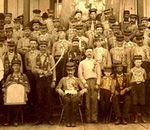 The grip of the old Orange machine on Toronto local politics did not finally start to end until the election of the city’s first Jewish mayor, Nathan Phillips, as “Mayor of all the People” in 1955. Mayor Phillips’s tenure in office lasted until 1962. His name now adorns the public square in front of the new city hall that was finally in place by 1967 – the locally buoyant and freshly optimistic centennial year of Macdonald and Cartier’s Canadian confederation of 1867.
The grip of the old Orange machine on Toronto local politics did not finally start to end until the election of the city’s first Jewish mayor, Nathan Phillips, as “Mayor of all the People” in 1955. Mayor Phillips’s tenure in office lasted until 1962. His name now adorns the public square in front of the new city hall that was finally in place by 1967 – the locally buoyant and freshly optimistic centennial year of Macdonald and Cartier’s Canadian confederation of 1867.
Ever since then, you might say, modern Toronto, along with much of modern Canada at large, has done its level best to forget about the Orange Order’s old “public power” (in Smyth’s words), that flourished in earlier eras. You might say too that over the past half century this instinct has made a lot of sense. Yet what the concluding remarks of both Houston and Smyth at the St. Michael’s College conference finally seemed to be saying, between the lines, was that nowadays, in the year 2005, perhaps it is time to start remembering the old public power of the Orange Order in Canada – in some measured but serious enough way at least, as what it really was: a part of the country’s real history which still has its real echoes today, which still or even increasingly need to be dealt with constructively in public life. And the ultimate argument here is simple and very well known. Those who forget their history are condemned to repeat it.
Further research down the road …
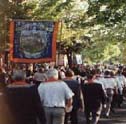 All good academic conferences end with musings on the implications of what has just been discussed for further research within the scholarly community. We live in an age of massive and rampant specialization, and everyone is finally most concerned about their own specialty – which is what they must live with from day to day.
All good academic conferences end with musings on the implications of what has just been discussed for further research within the scholarly community. We live in an age of massive and rampant specialization, and everyone is finally most concerned about their own specialty – which is what they must live with from day to day.
The November 5, 2005 St. Michael’s College conference on the Orange Order in Canada, I think, must finally be judged a very good academic conference – even, to some tastes at least, much better than most. And a little after 5 o’clock in the evening the current college principal, historian Mark G. McGowan, brought everything to a close with some suitable musings on what aspects of the old Orangeism it might be useful for historians of one sort or another to study next.
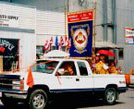 He said many interesting things, but two of them seem to have stood out most in my own mind. First, he returned to a question from the audience, asked earlier in the day, about connections between the Orange Order and the Ku Klux Klan in Canada. It had been asked by a gentleman who had traveled all the way from New Brunswick to attend the conference in Toronto, and who had brought some 1920s newspaper clippings that reported on the Orangemen and the Klan in the Maritime Provinces. Mark McGowan noted that in his Orange research, other such linkages could occasionally be noted in other parts of the country too. This was another subject worth further exploration.
He said many interesting things, but two of them seem to have stood out most in my own mind. First, he returned to a question from the audience, asked earlier in the day, about connections between the Orange Order and the Ku Klux Klan in Canada. It had been asked by a gentleman who had traveled all the way from New Brunswick to attend the conference in Toronto, and who had brought some 1920s newspaper clippings that reported on the Orangemen and the Klan in the Maritime Provinces. Mark McGowan noted that in his Orange research, other such linkages could occasionally be noted in other parts of the country too. This was another subject worth further exploration.
It was also a nice antidote to taking the general good humour and ironic laughter that accompanied the conference altogether too seriously. It does broadly seem that, through no real fault or virtue of anyone in particular, various aspects of the Canadian experience in the 19th and earlier 20th centuries worked to moderate the Orange Order – and even to somewhat expand its congenitally narrow view of the wider English-speaking future. And this probably has something to do with the comparative ease of the subsequent journey to the new multicultural Canada of today.
Only a few years ago now, however, the present-day Torontonian Tonya Lee Williams – best known for her portrayal of an African American princess on the TV soap opera The Young and the Restless, in the USA – spoke in a local TV interview about “the very quiet racism we have in Canada.” A historian concerned to explain this phenomenon might also want to say something about the Orange Order (as it used to be, at any rate, if not as it is now, among its 20 Orange lodges in west Africa, or its Irqouois lodges in Canada’s most populous province of Ontario).
 Mark McGowan’s second (and somewhat related) most striking thought came, as best as I can recall, at the very end of his very final remarks. He noted that most of the people at the November 2005 conference came from a generally similar older background in Canada, and other parts of the old empire on which the sun has now finally set. (Looking around at the audience you could even imagine that many probably descended from either old Green Irish Catholic or old Orange Irish Protestant families, getting along at last.) But it will be interesting, McGowan suggested, to see how younger historians from some of the newer old-world cultural backgrounds in Canada today finally see the history of the old Orange Order.
Mark McGowan’s second (and somewhat related) most striking thought came, as best as I can recall, at the very end of his very final remarks. He noted that most of the people at the November 2005 conference came from a generally similar older background in Canada, and other parts of the old empire on which the sun has now finally set. (Looking around at the audience you could even imagine that many probably descended from either old Green Irish Catholic or old Orange Irish Protestant families, getting along at last.) But it will be interesting, McGowan suggested, to see how younger historians from some of the newer old-world cultural backgrounds in Canada today finally see the history of the old Orange Order.
There were only a very few younger people in the audience at the conference who obviously and visibly qualified for the ranks of the future historians to which Mark McGowan was alluding. But there were just enough to make this seem exactly the right note on which to end.
Randall White is the author of a number of books, including Ontario 16101985: A Political and Economic History, and (with Jeanne MacDonald and Nadine Stoikoff) Toronto Women, Changing Faces, 19002000:A Photographic Journey. The proceedings of the November 5, 2005 conference at St. Michael’s College in Toronto will be published in 2006 by Four Courts Press, Dublin, under the title The Orange Order in Canada.
APPENDIX: GUY FAWKES AND THE GUNPOWDER PLOT
For those who may have forgotten about all this, here is the older received wisdom, as rather liberally conveyed by Sir George Clark in his concise English History: A Survey, first published in 1971:
“When parliament was about to meet for its second session in the autumn of 1605, a small group of catholic hotheads, men of good families, stuffed a cellar under the house of lords with gunpowder. They arranged to have a fifteen-minute time fuse lighted by Guy Fawkes, to explode while the king and both houses were together for the ceremonial opening.”
Fortunately, or otherwise, the plot was discovered beforehand: “Two days before parliament met on 5 November Fawkes was discovered in the cellar; he and seven other conspirators confessed their treason and were executed after trial.”
George Clark goes on to explain how there is “no reason to suppose that English catholics” generally “approved of the plot.” But it nonetheless led to further official anti-catholic measures: “Parliament passed a new Act against recusants” (i.e. people who refused to attend Protestant Church of England services), “and made sure that the country should remember the Gunpowder Plot. Special Prayers were added to the Prayer Book. The anniversary was kept thus until 1859.”


i have an old bible with note presented by The Prince Of Wales on initiation in the Orange Association 920 signed by David HADDER
Very biased article. The Roman Catholic Church was and is just as anti-Protestant as the Orange Order was anti-Catholic.
I gather Mr.Peel is not from and/or does not know much about the place where the academic conference discussed in my remarks here was held. The Catholic Church has never, eg, boasted the kind of influence in Toronto (or anglophone Canada more generally) that the Orange Order once did, from the middle of the 19th to the middle of the 20th centuries. No doubt the Inquisition was just as appalling as anything ever perpetrated by the Orange Order anywhere. But what I found refreshing about the conference discussed here was that it tried to transcend the old Catholic vs Protestant antagonisms, in Canada and elsewhere. Mr. Peel apparently wants to keep these conflicts alive. And I’d put it to him that he is the real “very biased” presence in this case. That in any event would be my opinion, as someone who was raised as a Baptist, who is now married to a person raised as a Catholic — and would report myself as “No religion” today if the census takers ever asked!
Very thought provoking !
Perhaps as interest in genealogy has increased among Canadians in recent years, more will seek to learn about their Orange Roots. The purpose of this website is to share information that may help them to find relatives who were members of the Loyal Orange Association in Canada.
The use of the term “storm troopers” is extremely biased and OBVIOUSLY offensive, and intended to be. It;’s a shame that this article comes up when researching the Orange Order in Canada.
Mr. Anderson should take up his complaints about “storm troopers” with the distinguished Canadian political historian P.B. Waite. Note too that the term is used in this particular connection with the phrase “of the Tories” which gives it different connotations than in other uses. It is, I think, meant to be taken in a somewhat jocular and even humourous way, and not as a political or cultural attack. It is certainly not intended to offend anyone, but meant to be taken more in the spirit of the conservative Canadian humourist of an earlier era, Stephen Leacock. That at any rate is how I used the term “storm troopers of the Tories” here. Bias like beauty perhaps is in the eye of the beholder.
The hostility between some orange men and some catholics will reduce as they mix with muslims,hindu and other non christian peoples. The enmity will reduce as they see how much more they have in common with each other. Similar sports,socialising and sense of humour to mention a few.
So ,in 20 years time we can say goodbye to all that festering sore since 1795.